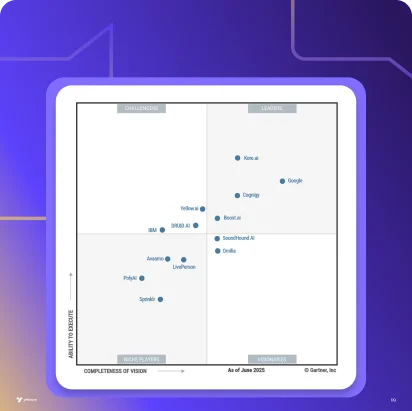Summary:
Customer feedback platforms have become the go-to solution for businesses wanting to understand and serve their customers better. Enterprises can modify their offerings to customer preferences, pain spots, and expectations via customer feedback. AI and machine learning are altering how businesses collect and assess such inputs. These technologies also facilitate advanced sentiment analysis and predictive analytics, offering deeper insights and personalized customer interactions. The US market, in particular, is leading the adoption of these advanced customer feedback tools, driven by a strong focus on customer-centric strategies and innovation.
This blog explores the significance of customer feedback platforms, detailing their benefits, key features, and criteria for selecting the most suitable one for your business. Enterprises in the process of choosing the most suitable customer feedback platforms can pick the best one from our comprehensive list of 12 such software. Whether you’re looking for customer feedback software, customer feedback tools, or online feedback software, this guide will provide the information you need to make an informed decision.
What is customer feedback?
Customer feedback is the information and inputs customers provide about their experience and view of a product or service. Simply, it indicates the comprehensive data gathered from customers using different tools and methodologies. Customer feedback aims to reveal consumers’ level of satisfaction.
Input can be gathered proactively by surveying and polling consumers, interviewing them, soliciting reviews, or deploying suitable tools for gathering indirect feedback.
It commonly expresses their reaction and response to a product/service/brand or their overall experience. Such insights are subsequently utilized to enhance an organization’s customer engagement, service, and satisfaction and to improve the areas where it is lacking.
What is a customer feedback platform?
A customer feedback platform is an advanced software solution which businesses can employ to gather, analyze, and act on feedback from their customers. These systems allow organizations to consolidate such inputs and evaluate customers’ emotions and experiences. These platforms are sought after because they transform raw customer feedback into actionable insights, which can drive strategic decisions and improvements in products or services.
Modern customer feedback software comes with advanced features like sentiment analysis, predictive analytics, and real-time reporting. By utilizing them, businesses can gain an in-depth understanding of customer needs and preferences, ultimately increasing customer satisfaction and loyalty.
To understand, let’s have a look at an example:
For example: An airline business using a customer feedback platform collects insights from passengers through post-flight surveys and in-app feedback forms. It analyzes the data to identify common pain points, such as delays or customer service issues, enabling the airline to implement targeted improvements and enhance the overall passenger experience.
To further answer the question of what is a customer feedback platform, one can consider the meaning of its three primary functions:
Collect feedback: Customer feedback platforms provide various channels for collecting feedback, such as email surveys, in-app feedback forms, social media, and online reviews. This multi-channel approach ensures that businesses can capture customer feedback at different touchpoints in their journey.
Analyze feedback: Once feedback is collected, the platform uses advanced analytics and sentiment analysis tools to process and interpret the data. These tools help identify trends, uncover customer pain points, and highlight areas for improvement. Businesses can obtain useful insights into customer satisfaction levels and overall experience by providing detailed reports and visualizations.
Act on feedback: It is crucial for continuous improvement. Businesses may respond to real-time feedback, route it to the right people, and make adjustments via consumer input tools. Integrating feedback into operational strategy improves products and services and boosts customer loyalty.
What features should customer feedback platforms have?
While selecting a robust customer feedback platform, consider 11 key features. Only then can businesses collect and analyze feedback to act on it effectively, driving continuous improvement and customer satisfaction.
- Feedback boards and roadmaps
Feedback boards enable customers to submit ideas and vote on feature requests. A roadmap showcases which features are planned, in progress, or recently launched, fostering transparency and engagement.
- Feedback collection widgets
Customizable, non-intrusive in-app or on-site widgets facilitate easy feedback submission directly from your product. These widgets enhance user convenience and encourage more frequent feedback.
- Changelog popups
Automatically display popups to announce new features and updates based on customer feedback. This keeps customers informed and demonstrates that their input is valued and acted upon.
- Omnichannel support
Effective customer feedback platforms must collect insights from various channels, including phone calls, live chat, SMS, email, social media, and web apps, ensuring comprehensive feedback coverage.
- Automated feedback collection
Utilize AI chatbots, voice assistants, and in-app/website widgets to automate feedback collection. These channels proactively solicit feedback, reducing the need for manual efforts and increasing response rates.
- Feedback analysis and prioritization
Analyze feedback to identify trends and common requests. Prioritize impactful ideas based on upvotes, customer value, and development efforts to first address the most critical areas.
- Closing the feedback loop
Keep customers informed about the status of their feedback. Notify them if their idea is planned, in progress, or not being considered, showing that their input is acknowledged and valued.
- Sentiment analysis
Sentiment analysis detects the tone (positive, negative, neutral) of customer comments, providing deeper insights into their overall experience and satisfaction.
- Reporting and dashboards
Generate comprehensive reports and dashboards to visualize feedback data, track trends, and share insights with your team. This facilitates data-driven decision-making and strategy formulation.
- Predictive analytics
Leverage machine learning models to analyze feedback patterns, predict future customer behavior, identify potential product issues, and anticipate market trends, allowing businesses to address concerns proactively.
- Multilingual support
Ensure an inclusive experience by allowing customers to submit feedback in their preferred language. This feature captures a broader range of input from a global user base, enhancing the platform’s reach and utility.
What are the benefits of customer feedback tools?
Leveraging customer feedback platforms authorizes businesses to tap into their customer base, gaining invaluable insights that inform product development, service enhancements, and overall customer experience strategies. Here are seven primary benefits of using customer feedback software:
1. Insights into customer needs and preferences
Customer feedback platforms provide precise insights into what customers need and prefer. Over 85% of SMBs feel online consumer feedback has helped business.
By collecting data from various touchpoints, businesses can customize their offerings, products and services to better meet customer expectations.
2. Identifying areas for improvement
Customer feedback tools help businesses identify customer experience issues. According to McKinsey, 70% of the customer’s journey depends on how they feel handled.
Analyzing feedback helps firms uncover recurring challenges and pain areas. This proactive strategy prevents customer unhappiness and improves product quality by addressing problems quickly.
3. Data-driven decision making
Rather than relying on assumptions or guesswork, businesses can base their decisions on real user experiences and preferences obtained as a solid foundation of data. This approach ensures that strategies are aligned with actual customer needs, leading to more effective and impactful business outcomes.
4. Staying competitive
Regular feedback helps businesses remain aligned with customer expectations and ahead of evolving trends. By continuously adapting to customer needs, businesses can retain a competitive edge and prevent competitors from gaining market share.
5. Enhanced product and service innovation
Customer feedback platforms enable businesses to innovate based on direct input from users. Enterprises can develop new features or services that directly address customer pain points by understanding what customers like and dislike. This ensures that new developments are well-received and impactful.
6. Tracking progress over time
With customer feedback tools, businesses can track changes and efforts. By constantly gathering and evaluating feedback, firms can monitor consumer happiness and loyalty. Businesses may optimize and improve by continuously assessing what works and what doesn’t.
7. Improved customer satisfaction and loyalty
Acting on customer feedback demonstrates that a business values its customers’ opinions. When customers see that their feedback leads to tangible changes, they are more likely to feel appreciated and remain loyal to the brand. This can boost customer retention and positive word-of-mouth, further driving business success.
“Coda is known for being customer obsessed. And we really do walk the talk when it comes to delivering exceptional customer experiences. To ensure we stay ahead, we’re always on the lookout for ways to improve the quality and efficiency of our responses to the diverse and wide range of our valued customers around the world. Yellow.ai has allowed us to do exactly this. It provides a gamified navigation experience, streamlining processes and setting high standards for responsiveness and service quality. With an intuitive interface tailored for a youthful demographic across six markets, 85% of customer queries are instantly resolved without human intervention, fostering loyalty and retention in a fiercely competitive landscape.”Bharati Amarnani, VP Customer Support & Product Operations
Best 12 customer feedback platforms in 2024
Best 12 customer feedback platforms in 2024
- Zonka Feedback
- Typeform
- Chisel
- QuestionPro
- SoGoSurvey
- SurveyMonkey
- Alchemer
- ProProfs Survey Maker
- Survicate
- SurveySparrow
- JotForm
- Qualtrics
Zonka Feedback
Zonka Feedback is an omnichannel consumer feedback software designed for small and large-scale businesses. It offers real-time alerts and digests to capture and close feedback loops effectively. Its AI features, including text and sentiment analysis, help analyze sentiments in guest satisfaction, employee, product, and facilities feedback. Zonka Feedback goes beyond measuring feedback across standard metrics like NPS, CSAT, and CES. It allows users to create short and long surveys based on feedback software and customer touchpoints. The tool is available for free or demo, and a lifetime free customer feedback version is available. A 14-day free trial for paid plans is also available.
Key features:
- Collect feedback through various channels
- Code-free survey builder and 100+ templates
- Multilingual surveys for global audiences
- AI-driven sentiment and text analysis
- Real-time dashboards and detailed analytics
Typeform
Businesses searching for an interactive customer feedback platform can consider Typeform. It is designed to engage users through dynamic surveys. This customer feedback software allows enterprises to create personalized survey flows with embedded images, videos, and icons, capturing the most relevant customer insights. Typeform features advanced survey logic and AI integration, ensuring seamless integration with various business tools. It supports creating unlimited surveys, each with up to 10 questions/ and 10 responses monthly, and offers a lifetime free account. Typeform gives a free plan with limited features, and there are paid plans, too.
Key features:
- Unlimited surveys with 10 questions/responses monthly
- Skip logic and hidden fields
- Extensive templates
- Downloadable survey data
- Integrations with Zapier, Slack, Mailchimp, HubSpot, etc.
Chisel
Businesses searching for an innovative customer feedback platform can consider Chisel. It can help enhance the process of gathering and analyzing customer insights. As customer feedback software, Chisel leverages AI-powered features like auto-labeling for streamlined ticket organization and a centralized repository called Idea Box for managing user ideas. It translates customer feedback into actionable roadmaps by connecting feedback to specific features, enabling businesses to make data-driven decisions. Chisel offers a free forever version and a 15-day premium trial with no subscription charges.
Key features:
- Idea Box for centralizing user ideas
- AI-powered auto-labeling for ticket organization
- Feedback Portal for managing feedback with a link
- Build surveys from scratch or use templates
- Roadmap prioritization based on user feedback
QuestionPro
QuestionPro customer feedback software enables enterprises to gather both qualitative and quantitative feedback through customizable surveys. It supports centralized feedback management, offering tools for branching, skip logic, and integration with various platforms. Its surveys can be tailored to align with your brand theme, enhancing brand recall. This customer feedback platform provides unlimited free surveys, each accommodating up to 300 responses, ensuring wide-ranging customer insights. QuestionPro offers a free plan with limited features and paid plans.
Key features:
- Access for one member
- 30+ question types
- Customizable surveys for branding
- Skip logic functionality
- Integration with Google Sheets
SoGoSurvey
Sogolytics, formerly SoGoSurvey, is a tool that assists companies in creating sophisticated surveys to gather customer feedback. It is suitable for various data collection projects, including surveys, forms, polls, employee pulse checks, risk assessments, and customer experience management. Sogolytics offers features like 360-degree feedback, NPS surveys, workflow automation, API integration, and panel management. It is a top free customer feedback tool suitable for businesses of all sizes, with a short learning curve. However, the free plan does not offer integration benefits. A lifetime free plan is available for this customer feedback tool.
Key features:
- Template bank with customizable reports
- Social media sharing
- One-click reports
- Built-in data analytics (Predictive Analytics)
- SSL encryption
SurveyMonkey
SurveyMonkey is an online survey tool with over 100 integrations with various apps and plug-ins. This customer feedback software enables users to easily create and send surveys, providing valuable insights into customer thoughts and experiences. It offers data management, allowing users to access all survey data on a single dashboard and analyze it using graphs and charts. The platform offers pre-made templates and customization options to align surveys with your brand. Businesses can analyze data through a centralized dashboard using graphs and charts for informed decision-making. The basic plan is free, allowing unlimited surveys with up to 10 questions, but response limits apply.
Key features:
- Survey sharing with fine control over access
- Multilingual surveys
- Free integrations with collaboration apps
- Export data in CSV, PDF, PPT, SPSS, and XLS formats
- Advanced analysis features
Alchemer
Businesses can use the Alchemer customer feedback platform to collect, analyze, and act on customer feedback efficiently. This customer feedback software offers advanced customization options, comprehensive survey features, and robust reporting and analytics capabilities. Alchemer supports businesses in understanding their customers better and improving service quality. It includes free templates for creating unlimited surveys and supports various feedback channels. However, the free version has limitations, such as viewing only recent 12-hour data and no option to download old reports. There is a free basic plan offering limited features.
Key features:
- Up to 5 contacts in email surveys
- API – 60 requests per minute
- Advanced customization options
- Comprehensive survey features
- Robust reporting and analytics
ProProfs Survey Maker
ProProfs Survey Maker customer feedback platform is meant for businesses of all sizes to generate engaging surveys, forms, quizzes, and assessments. This customer feedback software offers professionally designed templates that can be customized to align with your brand’s colors, fonts, and logos. Businesses can gather real-time feedback via email, social media, or embedded website widgets. With advanced reporting and intelligent analytics, ProProfs Survey Maker aids businesses in enhancing customer service and satisfaction. Make use of its advanced reporting with intelligent analytics to analyze the data. Enterprises can opt for its free plan to test the performance.
Key features:
- Unlimited surveys
- Respondent email notification
- Net Promoter Score
- Skip Logic
- 20+ question types
- Notifications & report sharing
- Multilingual surveys
Survicate
With the Survicate customer feedback platform, businesses can gather insights from their customers across various digital channels. This software supports email, link, chat, and in-product surveys, enabling enterprises to engage with customers and gather feedback seamlessly. Survicate’s intuitive interface, comprehensive survey question types, and robust integrations with popular business tools make it an ideal choice for understanding customer needs and improving service quality. With advanced targeting and user segmentation, businesses can send surveys to the right audience at the right moment. Free plan available.
Key features:
- Multiple survey distribution channels
- NPS, CSAT, CES, and 12 more survey types
- Customizable surveys without coding
- Integrates with HubSpot, Intercom, and 26+ tools
- Advanced targeting and user segmentation
SurveySparrow
SurveySparrow customer feedback platform can arm you with a unique and interactive way to engage with your customers. It transforms traditional surveys into engaging conversations, enhancing response rates and customer satisfaction, and the credit goes to its conversational, chat-like interface. A few of its salient characteristics are conditional branching, multilingual support, seamless integration with popular business tools and the facility to personalize surveys. It enables businesses to gather actionable insights in real time, improving customer service and overall experience. There is a free trial for 14 days; paid plans start at $19 per month.
Key features:
- Conversational surveys with chat-like interfaces
- Conditional branching and skip logic
- Customizable survey themes and branding options
- Multilingual surveys for a global audience
- Integration with tools like Slack, Salesforce, and HubSpot
JotForm
With the JotForm customer feedback platform, businesses can create, share, and analyze dynamic surveys. It allows for the seamless collection of insights from various channels, including emails, websites, and mobile apps. Users can leverage JotForm’s intuitive drag-and-drop builder to design custom surveys, facilitating real-time feedback collection and advanced data analysis through auto-generated reports, dashboards, and graphs. This customer feedback software caters to businesses of all sizes, ensuring robust data security and an array of customization options. A free starter plan is available; monthly paid subscriptions start at $34.
Key Features:
- Simplifies survey creation with drag-and-drop builder
- Real-time feedback collection across multiple channels
- No-code drag-and-drop builder
- Reports, dashboards, and analytics tool
- Mobile-responsive design
Qualtrics
Using Qualtrics as a customer feedback platform, businesses can collect, analyze, and act on customer insights drawn from multiple channels, including email, websites, and social media. This software provides advanced analytics and AI-powered insights, allowing businesses to detect emotions and intent in customer feedback. Qualtrics’ comprehensive suite of features aids in managing and improving customer experiences through customized surveys and detailed data analysis. It integrates with CRM systems and other customer support platforms. For pricing, contact the Qualtrics team.
Key features:
- Advanced analytics with powerful data tools
- Generate insightful reports and visualizations
- Integrates with popular business tools
- Robust survey customization options
- Collect feedback on 125+ channels
How to choose customer feedback software?
Choosing the right customer feedback platform is necessary for businesses striving to improve their products, services, and customer experiences. Here are ten factors to consider when selecting the best customer feedback software:
1. Evaluate your needs and goals
Define your goals. Why are you collecting feedback? Are you aiming to measure customer satisfaction, understand pain points, or improve product features? Decide the type of feedback you need (surveys, in-app feedback, etc.) and specify who will use the tool, such as marketing teams, customer service representatives, or developers.
2. Identify essential features and functionality
Choose a platform with a simple survey builder and many question types. Reporting and analytics should provide clear, actionable insights. This tool should target and segment certain client groups. Inspect it thoroughly to ensure it can receive input through all available channels, including email, websites, applications, and social media. Automation and follow-up to automate feedback-based activities are essential.
3. Consider budget and pricing
Compare tools based on pricing and your budget. Consider how much you are willing to spend and the pricing model, whether it’s subscription-based, pay-as-you-go, or another model. Look for options that offer free plans to check the software before investing financially.
4. Assess ease of use and support
The tool should be easy to use and supported by reliable customer service. The customer support team must be able to learn it without any difficulties. The quality and availability of customer support are essential. Meanwhile, the customer feedback tool must contain comprehensive documentation and training resources for onboarding your team.
5. Integration compatibility
The customer feedback platform must integrate effortlessly with your existing tools, such as CRM, customer support systems and marketing automation. It must have CRM integration to sync feedback with customer profiles. Likewise, API should be available to connect with other software solutions.
6. Ensure security and compliance
Data security is paramount. Ensure the platform complies with relevant regulations, such as GDPR or CCPA. Key aspects include data encryption to protect data during transfer and storage and privacy controls that allow you to manage and secure customer data effectively.
7. Check scalability
Your selected platform should grow with your business. Assess whether it can handle an increasing volume of feedback as your business expands and if it will maintain performance under higher loads. Scalability is crucial for long-term usability.
8. Evaluate customization options
The customer feedback platform must allow customization to align with your brand and business processes. Opt for flexible design options to adjust the look and feel to match your brand, and workflow modification to adjust workflows to suit your operational needs.
9. Take advantage of free trials and demos
Most customer feedback software offers trial periods or demos. A trial period allows you to assess functionality and ease of integration, while demo sessions provide a hands-on experience of the tool’s features.
10. Read user reviews and case studies
Social proofing can narrate a lot about a platform’s performance. So, check reviews and case studies to understand the platform’s real-world performance. Look for testimonials from current users and case studies that provide examples of how other businesses have benefited from the software. Negative feedback on social media and online reviews may quickly damage a brand. 72% of Americans review local businesses, which implies that client voices are louder and more crucial than ever.
Improve your customer feedback with Yellow.ai
Customer service automation powered by AI is reshaping how a modern business connects, interacts, engages, responds and understands its customers. This is where Yellow.ai has been helping leading brands across the globe embrace automation driven by Gen-AI to improve customer interaction, and experience and ease the feedback collection, analysis and utilization process.
Forget clunky surveys and time-consuming manual analysis. Yellow.ai’s NLP-powered bots are revolutionizing customer feedback collection. Its advanced AI assistants capture real-time insights from every customer interaction, across websites, chatbots, social media, and email. Gone are the language barriers – Yellow.ai can decipher complex feedback, regardless of the language used. The result? A holistic, global view of customer sentiment, delivered in actionable data. This empowers enterprises to make data-driven decisions that enhance customer satisfaction and loyalty and boost their bottom line.
Key features of Yellow.ai
- Sentiment analysis: Using futuristic NLP and machine learning, the Yellow.ai platform helps enterprises discern customer sentiments.
- Personalized response: You can also understand patrons’ queries accurately, offering personalized responses and gathering feedback seamlessly.
- Multilingual prowess: Communicate with customers in their native tongue to eliminate linguistic obstacles and ensure their feedback is accurately translated.
- Omnichannel feedback collection: Thanks to Yellow.ai, businesses can set up an omnichannel presence and gather feedback effortlessly through live chat, voice agents, email automation, and more. It makes customers feel valued and heard by routing complex questions to human representatives.
- Robust analytics: Use robust analytics to transform consumer input into insightful data, allowing organizations to prioritize product and service changes.
Summing up: Customer feedback platform
Customer feedback platforms are essential tools that enable enterprises to gather, analyze, and act on customer insights. This blog has covered the meaning, key features, and selection criteria for a customer feedback platform, highlighting how these tools enhance customer service. A list of the best customer feedback platforms has been provided, allowing businesses to choose based on their objectives, budget, industry needs, and compatibility.
The future of customer feedback platforms is poised for significant advancements driven by AI and machine learning. As a consumer-driven market and worldwide business shift, North America’s customer feedback helped innovate and strengthen customer connections. Businesses can expect real-time sentiment analysis, theme detection, and predictive analytics to become standard features. These platforms will integrate feedback from multiple channels, with a holistic view of the customer journey and enabling personalized interactions. As the market is expected to reach USD 5362.9 million by 2031, growing at a CAGR of 12.7%, opting for a customer feedback platform will be essential for businesses to remain competitive, enhance customer satisfaction, and drive data-driven decisions in modern customer service.
Customer feedback platform: FAQs
How does a customer feedback platform work?
A customer feedback platform works by helping a business collect its customers’ inputs or opinions proactively by polling and surveying them and also interviewing them. It assists enterprises in collecting, managing, and analyzing feedback from their customers. Sometimes, it asks customers to review any product, feature, service, or brand as a whole. Customer service teams can also passively or indirectly gather feedback by providing users with a place to share comments, complaints, or compliments on the product.
What types of feedback can I collect with these platforms?
You can collect a wide range of feedback using a customer feedback platform. However, they can be categorized into two primary types:
Quantitative feedback:
It includes number-based inputs or responses such as ratings, scores and clickstream data.
Ratings: Customers can rate their satisfaction with a product, service, or interaction on a scale (e.g., star ratings, Net Promoter Score).
Scores: Platforms may capture specific scores for different aspects of the experience (e.g., ease of use, product quality, customer service).
Clickstream data: Tracks customer journeys through a website or app, revealing usage patterns and potential pain points.
Qualitative feedback:
This type of feedback is open-ended and covers customer comments, reviews, surveys, etc.
Reviews and comments: After experiencing a product or service, customers can write thorough reviews or comments expressing their opinions and views.
Surveys: Using such a tool, you can host surveys with open-ended questions about your business to gather in-depth feedback on specific products, services, or experiences.
Social media sentiment analysis: Some customer feedback platforms can analyze social media mentions and tagging to discern customers’ sentiments and perspectives towards the brand. You can detect whether it is positive, negative, or neutral.
How can a customer feedback platform improve customer retention?
Customer feedback platforms can improve customer retention as inputs gathered through such platforms can provide valuable insights into what features or upgrades customers want to experience or see. Businesses can use this feedback to include in their product development efforts, leading to tweaking or upgrading services and products that better meet customers’ expectations and needs. Such initiatives make the customers feel heard, valued and seen by the brands, increasing customer satisfaction, loyalty and retention. It reduces the customer churn rate, too.
What is the best way to encourage customers to provide feedback?
There are different best ways to encourage customers to provide feedback. You must explain the advantages of input to the customers and nudge them to be the first to add your personal experience. It can be divided into a few key steps:
- Motivate customers to give feedback.
- Furnish them with feedback boxes.
- Create clear and easy-to-follow surveys.
- Ask your customer service and support teams to reach out to them personally.
- Form an online community. Instead of collecting social media comments, develop your network. Enable forums on your website.
- Use social media as a communication platform to engage with your customers and give them feedback as social proofing.
- Incentives like discount vouchers or entry into a contest for a higher prize might encourage customers to write reviews.
- Respond to and acknowledge customer feedback, echoing how important it is for you.
- Create a feedback culture.
- Analyze and act on feedback.
- Send Email and NPS surveys.
























